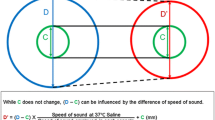Abstract
Purpose
To determine the accuracy and reproducibility of luminal dimension measurements of a newly developed method of quantitative angioscopy.
Methods
A method was developed for quantitation of luminal dimensions during angioscopy, as variation in magnification with lens-object distance and ambiguity associated with identification of corresponding points about the circumference of a given discrete cross-section render subjective estimates unreliable. A transverse ring of fiberoptically transmitted light was emitted from a guidewire or its housing at a known distance from the distal end of an angioscope and discrete cross-sections of interest were observed as the ring of light was reflected from the luminal surface. Caliper measurement of the diameter of the light ring image (< 50 mW at 488/515 nm), obtained on angioscopic video recordings of cylindrical phantom vessels of known dimensions, was performed by three observers on five occasions.
Results
The mean absolute difference between measured and known luminal diameter (n = 405 observations) was 65 μm±35 μm and the mean coefficient of variation was 4.2%, and the mean difference between measured and known areas (n = 195 observations) was 0.4 mm2, with a mean coefficient of variation of 6.5%.
Conclusion
By use of this new lightwire method, luminal dimensions can now be measuredin vitro with a high degree of accuracy and reproducibility during angioscopy.
Similar content being viewed by others
References
Spears JR, Marais HJ, Serur J, Pomerantzeff O, Geyer R, Weintraub R, Thurer R, Gerstin R, Paulin S, Grossman W (1983) In vivo coronary angioscopy. J Am Coll Cardiol 1:1311–1314
Spears JR, Spokojny AM, Grossman W (1985) Coronary angioscopy during cardiac catheterization. J Am Coll Cardiol 6:93–97
Grundfest WS, Litvack F, Sherman T, Caroll R, Lee M, Chaux A, Kass R, Matloff J, Berci G, Swan HJ, Morgenstern L, Forrester J (1985) Delineation of peripheral and coronary detail by intraoperative angioscopy. Ann Surg 202:394–400
Lee G, Garcia JM, Corso PJ, Chan MG, Rink JL, Pichard A, Lee KK, Reis RL, Mason DT (1986) Correlation of coronary angioscopic to angiographic findings in coronary artery disease. Am J Cardiol 58:238–241
Sherman CT, Litvack F, Grundfest WS, Lee M, Hickey A, Chaux A, Kass R, Blanche C, Matloff J, Morgenstern L, Ganz W, Swan HJC, Forrester J (1986) Coronary angioscopy in patients with unstable angina pectoris. N Engl J Med 315:912–919
Sanborn TA, Rygaard JA, Westbrook BM, Lazar HL, McCormick JR, Roberts AJ (1986) Intraoperative angioscopy of saphenous vein and coronary arteries. J Thorac Cardiovasc Surg 91:339–343
Konishi T, Inden M, Nakano T (1989) Clinical experience with percutaneous coronary angioscopy in cases with coronary artery disease. Angiology 40:18–23
Ramee SR, White CJ, Collins TJ, Mesa JE, Murgo JP (1991) Percutaneous angioscopy during coronary angioplasty using a steerable microangioscope. J Am Coll Cardiol 17:100–105
White CJ, Ramee SR, Mesa JE, Collins TJ (1991) Percutaneous coronary angioscopy in patients with restenosis after coronary angioplasty. J Am Coll Cardiol 17:46B–49B
Siegel RJ, Ariani M, Fishbein MC, Chae JS, Park JC, Maurer G, Forrester JS (1991) Histopathologic validation of angioscopy and intravascular ultrasound. Circulation 84:109–117
Crawford DW, Brooks SH, Barndt R Jr, Blankenhorn DH (1977) Measurement of atherosclerotic luminal irregularity and obstruction by radiographic densitometry. Invest Radiol 12:307–313
Cheong W-F, Prahl SA, Welch AJ (1990) A review of the optical properties of biological tissues. IEEE J Quant Elect 26:2166–2185
Spears JR, Sandor T (1986) Quantitation of coronary stenosis severity: Limitations of angiography and computerized information extraction. In: Reiber JHC, Serruys PW (eds). State of the art in quantitative arteriography. Martinus Nijhoff Publishers Amsterdam, pp 103–124
Brown BG, Bolson EL, Frimer M, Dodge HT (1977) Quantitative coronary arteriography: Estimation of dimensions, hemodynamic resistance, and atheroma mass of coronary artery lesions using the arteriogram and digital computation. Circulation 55:329–337
Crawford DW, Brooks SH, Selzer RH, Brandt R Jr, Beckenbach ES, Blankenhorn DH (1977) Computer densitometry for angiographic assessment of arterial cholesterol content and gross pathology in human atherosclerosis. J Lab Clin Med 89:378–392
Alderman EL, Berte LE, Harrison DC, Sanders W (1981) Quantitation of coronary artery dimensions using digital image processing. Diagn Radiol 314:273–277
Spears JR, Sandor T, Als AV, Malagold M, Markis JE, Grossman W, Serur JR, Paulin S (1983) Computerized image analysis for quantitative measurement of vessel diameter from cineangiograms. Circulation 68:453–461
Mancini GBJ, Simon SB, McGillem MJ, Le Free MT, Friedman HZ, Vogel RA (1987) Automated quantitative coronary arteriography: Morphologic and physiologic validation in vivo of a rapid digital angiographic method. Circulation 75:452–460
Selzer RH, Hagerty C, Azen SP, Siebes M, Lee P, Shircore A, Blankenhorn DH (1989) Precision and reproducibility of quantitative coronary angiography with applications to controlled clinical trials. J Clin Invest 83:520–526
Reiber JHC (1991) An overview of coronary quantitation techniques as of 1989. In: Reiber JHC, Serruys PW (eds): Quantitative coronary arteriography. Kluwer Academic Publishers, Dordrecht, pp 55–132
Spears JR, Sandor T, Baim DS, Paulin S (1983) The minimum error in estimating coronary luminal cross-sectional area from cineangiographic diameter measurements. Cath Cardiovasc Diagn 9:119–128
Serruys PW, Reiber JH, Wijns W,van den Brand M, Kooijman CJ, ten Katen HJ, Hugenholtz PG (1984) Assessment of percutaneous transluminal coronary angioplasty by quantitative coronary angiography: Diameter versus densitometric area measurements. Am J Cardiol 54:482–488
Spokojny AM, Serur JR, Skillman J, Spears JR (1986) Uptake of hematoporphyrin derivative by atheromatous plaques: Studies in human in vitro and rabbit in vivo. J Am Coll Cardiol 8:1387–1392
Author information
Authors and Affiliations
Rights and permissions
About this article
Cite this article
Spears, J.R., Ali, M., Raza, S.J. et al. Quantitative angioscopy: A novel method of measurement of luminal dimensions during angioscopy with the use of a “lightwire”. Cardiovasc Intervent Radiol 17, 197–203 (1994). https://doi.org/10.1007/BF00571534
Issue Date:
DOI: https://doi.org/10.1007/BF00571534




